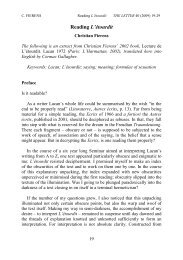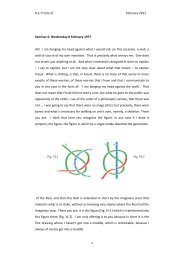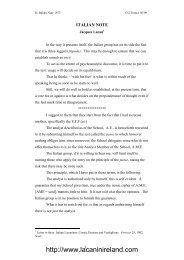Borromean knot with that of the Imag<strong>in</strong>ary and of the Symbolic. The Real,as it appears, the Real tells the Truth, but it does not speak and one mustspeak <strong>in</strong> order to say anyth<strong>in</strong>g. The Symbolic, for its part, supported by thesignifier, only tells lies when it speaks; and it speaks a lot. It ord<strong>in</strong>arilyexpresses itself by the Verne<strong>in</strong>ung, but the contrary of the Verne<strong>in</strong>ung, assomeone who was good enough to take the floor dur<strong>in</strong>g my first sem<strong>in</strong>ar,the contrary of the Verne<strong>in</strong>ung, <strong>in</strong> other words of what is accompanied bynegation, the contrary of the Verne<strong>in</strong>ung does not give the Truth. It existswhen one speaks of a contrary, one is always speak<strong>in</strong>g about someth<strong>in</strong>g thatexists, and which is true about one particular among others; but there is nouniversal that corresponds to it <strong>in</strong> that case. And that by which theVerne<strong>in</strong>ung is typically recognised, is that one must say someth<strong>in</strong>g false, tosucceed <strong>in</strong> gett<strong>in</strong>g across a truth. Someth<strong>in</strong>g false is not a lie, it is only a lieif it is willed to be such, which often happens, if it is aim<strong>in</strong>g <strong>in</strong> a way at a liepass<strong>in</strong>g for the truth; but it must be clearly said that, apart frompsychoanalysis, it is rare. It is <strong>in</strong> psychoanalysis that this promotion of theVerne<strong>in</strong>ung, namely, of the lie willed as such to get a truth across, isexemplary. All this, of course, is only knotted by means of the Imag<strong>in</strong>arywhich is always wrong. It is always wrong, but it is on it that there dependswhat is called consciousness.Consciousness is very far from be<strong>in</strong>g knowledge, s<strong>in</strong>ce, what it lends itselfto is very precisely falsity. ‘I know’ never means anyth<strong>in</strong>g, and one caneasily wager, that what one knows is false; is false but is susta<strong>in</strong>ed byconsciousness, whose characteristic is precisely to support this false by itsconsistency. To the po<strong>in</strong>t that one could say that, one should look twicebefore admitt<strong>in</strong>g someth<strong>in</strong>g obvious, that it must be sifted as such, thatnoth<strong>in</strong>g is sure <strong>in</strong> matters of obviousness, and that that is why I enunciatedthat the obvious (l’évidence) must be emptied out (évider) that what isobvious depends on this empty<strong>in</strong>g out.It is very strik<strong>in</strong>g that – I can well, for my part also, go on to the order ofconfidences with which I am crushed <strong>in</strong> my daily analyses – an ‘I know’that is conscious, namely, not simply knowledge, but the will not to change,86
is someth<strong>in</strong>g which is, I can confide <strong>in</strong> you, experienced very early on,experienced by the fact of someone, like everyone, who was close to me,namely, the one that I called at that time, I was two years older than her, twoand a half years, my little sister, she is called Madele<strong>in</strong>e and she said to meone day, not ‘I know’, because the ‘I’ would have been too much, but‘Manène knows’.The unconscious is an entity that I try to def<strong>in</strong>e by the Symbolic, which isonly <strong>in</strong> short an extra entity. An entity with which one must know how todeal. Know<strong>in</strong>g how to deal with it, is not the same th<strong>in</strong>g as a knowledge, asthe Absolute Knowledge of which I spoke earlier. The unconscious is whatprecisely makes someth<strong>in</strong>g change, what reduces what I called the s<strong>in</strong>thome,the s<strong>in</strong>thome which I write with the orthography that you know.I always had to deal with consciousness, but <strong>in</strong> the form which formed partof the unconscious, s<strong>in</strong>ce it is a person a ‘she’ on this particular occasion, a‘she’ s<strong>in</strong>ce the person <strong>in</strong> question put herself <strong>in</strong> the third person by nam<strong>in</strong>gherself Manène, <strong>in</strong> a form which formed part of the unconscious, I amsay<strong>in</strong>g, s<strong>in</strong>ce it is a ‘she’ who, as <strong>in</strong> my title for this year, a ‘she’ qui s’ailaità mourre who pretended to be a bearer of knowledge.He or she, is the third person, is the Other, as I def<strong>in</strong>e it, it is theunconscious. It knows, <strong>in</strong> the absolute, and only <strong>in</strong> the absolute, it knowsthat I know what was <strong>in</strong> the letter, but that I alone know. In reality, ittherefore knows noth<strong>in</strong>g, except that I know it, but this is not a reason that Ishould tell him.In fact, this Absolute Knowledge, I did more than allude to it somewhere, Ireally <strong>in</strong>sisted on it with my big boots, namely, that the whole appendix thatI added to my writ<strong>in</strong>g on The purlo<strong>in</strong>ed letter, namely, what goes from page54 to page 60, and that I entitled <strong>in</strong> part ‘Parenthesis of parentheses’, is veryprecisely this someth<strong>in</strong>g which, here, is substituted by Bozef.87
- Page 1:
Seminar 1: Wednesday 16 November 19
- Page 5 and 6:
after all noticed that to consist m
- Page 7 and 8:
It would be enough for you to take
- Page 9 and 10:
There had therefore been a turning
- Page 11:
Supposing that we have a torus in a
- Page 15 and 16:
topology encourages us to do so. Th
- Page 17 and 18:
and me, and I who, in short, by din
- Page 19 and 20:
we cut it in two, the front and the
- Page 21 and 22:
is itself a hole and in a certain w
- Page 23 and 24:
Everyone knows that this is how thi
- Page 25 and 26:
Seminar 3: Wednesday 21 December 19
- Page 27 and 28:
proceed to this double cut, a doubl
- Page 29 and 30:
The inside and the outside in this
- Page 31 and 32:
egards the structure of the body, o
- Page 33 and 34:
inspired by it and its inspiration,
- Page 35 and 36: music on you, is that it has this p
- Page 37 and 38: from the beloved to the lover. What
- Page 39 and 40: that the little o-object is not uni
- Page 41 and 42: Seminar 4: Wednesday 11 January 197
- Page 43 and 44: short I called the discourses; the
- Page 45 and 46: It is flattened out, and in a way t
- Page 47 and 48: astonishes me still more, is not th
- Page 49 and 50: Seminar 5: Wednesday 18 January 197
- Page 51 and 52: see it here, namely, something that
- Page 53 and 54: namely, that everything that concer
- Page 55 and 56: Let’s see. Let us try to see here
- Page 57 and 58: - X: You can’t hear me because pr
- Page 59 and 60: Seminar 6: Wednesday 8 February 197
- Page 61 and 62: its relationship to the body that w
- Page 63 and 64: that in the position B1, would be t
- Page 65 and 66: is in the position of maintaining t
- Page 67 and 68: Effectively the problem of primary
- Page 69 and 70: which I will return later, what is
- Page 71 and 72: the object of desire is not unknown
- Page 73 and 74: that he tells the truth. You see th
- Page 75 and 76: look of the Real, there is not, for
- Page 77 and 78: accentuated by him is the search fo
- Page 79 and 80: What is happening, is it not, the d
- Page 81: grounded and articulatable way, and
- Page 84 and 85: eason is said to be purloined, whil
- Page 88 and 89: Alain Didier Weill, for his part, i
- Page 90 and 91: Seminar 8: Wednesday 8 March 1977Wh
- Page 92 and 93: shouldn’t tell you, at 7.15 at Ju
- Page 94 and 95: means that the tongue fails, that,
- Page 96 and 97: of his time as a formidable cleric
- Page 98 and 99: It is very difficult not to waver o
- Page 100 and 101: I remind you that the place of semb
- Page 102 and 103: this term in the feminine, since th
- Page 104 and 105: which coincides with my experience,
- Page 106 and 107: and to put that for you in black an
- Page 108 and 109: see, does not see too great an inco
- Page 110 and 111: that exists, he says what he believ
- Page 112 and 113: In short, one must all the same rai
- Page 114 and 115: particular besides, neurotic, a sex
- Page 116 and 117: functioning as something else. And
- Page 118 and 119: mean to deny? What can one deny? Th
- Page 120 and 121: slipping from word to word, and thi
- Page 122 and 123: Seminar 12: 17 May 1977People in th
- Page 124 and 125: y writing. And writing only produce
- Page 126 and 127: not pinpointed it? He calls this a














